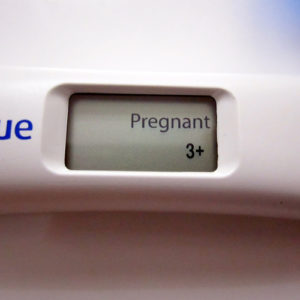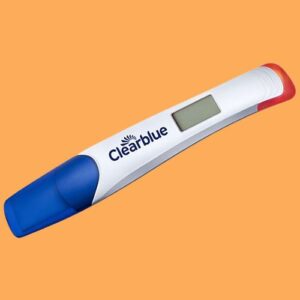What is an IUD?
An IUD, or intrauterine device, is a tiny T-shaped plastic device that contains copper. It is inserted into the womb (uterus) by a specially trained nurse or doctor and protects against pregnancy for between 5-10 years. It works by releasing copper to stop sperm reaching and fertilising an egg. The IUD is over 99% effective at preventing pregnancy when fitted correctly.
The IUD is sometimes called a “coil” or “copper coil” due to its shape. It should not be confused with the intrauterine system (IUS) which contains the hormone progestogen instead of copper.
How Does the IUD Work?
The copper released by the IUD makes it harder for sperm to travel through the womb and fertilise an egg in two ways:
- It makes the mucus in the cervix thicker, stopping sperm from reaching or fertilising an egg
- It can also prevent a fertilised egg from being able to implant in the womb
If fitted over age 40, the IUD can be left in place until menopause or whenever contraception is no longer needed.
Getting an IUD Fitted
An IUD takes around 20-30 minutes to fit and the actual insertion takes less than 5 minutes. It can be inserted at any point in your menstrual cycle, as long as you are not already pregnant.
Before fitting the IUD, the doctor or nurse will:
- Check the position and size of your womb
- Test for any infections like STIs
- Provide any needed antibiotics
To insert the IUD, the vagina is held open as it would be during a smear test. The IUD is inserted through the cervix and into place in the womb.
The process can be uncomfortable or painful for some. Discuss options for numbing the area with your doctor or nurse beforehand if needed.
Getting Your IUD
In the UK, IUD insertion is fully free and confidential, including for those under 16 years old. You can get an IUD at:
- Contraception/sexual health clinics
- GUM (genitourinary medicine) clinics
- Your GP surgery
- Some youth health services
You can also visit this NHS webpage and enter your postcode to find your closest sexual health clinic for IUD services.
No parental permission is needed for those under 16 to get an IUD – the service will encourage telling your parents but does not require it.
What to Expect at Your IUD Fitting Appointment
- Before the appointment, consider taking over-the-counter pain medication like ibuprofen to help minimise cramping afterwards.
- The room will be private and you can have someone accompany you if it makes you more comfortable.
- You will be asked to undress from the waist down and given a sheet to cover yourself during the procedure. The position will be similar to during a cervical screening test.
- The doctor will first examine you internally to check the size and position of your womb, which can cause mild discomfort.
- When you are ready, the vaginal opening is held in position with an instrument called a speculum. The IUD is then inserted through a thin tube that goes through the cervix and into the womb.
- You may experience cramping or stinging during the sounding of the uterus and actual insertion. Let the doctor know if you need to take a break at any point.
- The whole fitting generally takes just a few minutes. The doctor will trim the IUD strings so they hang into your vagina.
Looking After Yourself Afterwards
You may have period-type cramps and some light bleeding for a few days after your IUD is inserted. The following can help with discomfort:
- Use a hot water bottle on your abdomen
- Take over-the-counter painkillers like paracetamol as needed
- Wear panty liners and avoid using tampons for several days
Your doctor will advise you to come back after 3-6 weeks to make sure the IUD is in proper position and you are recovering well. In the meantime, here are some things you should do:
- Check you can feel the IUD strings after your period ends
- Use condoms/backup contraception for the first 7 days
- Avoid penetrative sex for at least 3 days
- Call your doctor if you have signs of infection
Living with Your IUD
Once settled, an IUD requires minimal maintenance. You should:
- Check you can feel the IUD strings after each period
- Have an annual pelvic exam and STI test if needed
- Use condoms with new sexual partners
- Remember it does not protect against STIs
- Call your doctor promptly if you suspect pregnancy
For the first 3-6 months, it is common to have heavier periods and cramping or spotting between periods as your body adjusts. You can manage this by:
- Using a calendar to track symptoms
- Taking over-the-counter pain medication
- Trying a heating pad for cramps
- Wearing backup menstrual products
If symptoms remain problematic over 6 months, discuss the options with your doctor. There are treatments that can help, or you may wish to consider a different contraceptive method.
Checking Your IUD
An IUD has two thin threads that hang down into the top of the vagina. After insertion, the doctor or nurse will show you how to check the threads to make sure the IUD stays in proper position.
Check for the threads:
- A few times in the first month
- After each period
- At regular intervals
If you cannot feel the threads or think the IUD has moved, you may not be protected against pregnancy. See your doctor ASAP and use backup contraception like condoms until it can be checked.
Getting Your IUD Removed
A doctor or nurse specially trained in IUD removal can take it out at any time. Make sure to use backup contraception like condoms for 7 days before removal if you do not want to become pregnant.
Once removed, fertility returns to normal right away and you can get pregnant very soon after, so discuss options with your healthcare provider if you wish to prevent pregnancy.
Who Can Use an IUD?
Generally, anyone with a womb can use an IUD, but your medical history is reviewed to determine if an IUD is suitable for you. It may not be recommended if:
- You think you are pregnant
- You have an untreated STI
- You have womb or cervix issues
- You have abnormal bleeding
Special considerations apply for those who:
- Have had ectopic pregnancy
- Have an artificial heart valve
Always consult your doctor first.
The IUD can be used safely after normal childbirth, c-section, miscarriage or abortion when properly timed – discuss when to fit it with your healthcare provider.
The Pros and Cons of IUDs
Advantages of the IUD include:
- Over 99% effective for 5-10 years
- Works immediately after insertion
- Can be used by most with womb
- No hormones or related side effects
- Does not interfere with sex
- Safe for breastfeeding mums
- Fertility returns quickly after removal
- Does not interact with other medications
Disadvantages to consider:
- Heavier, longer, more painful periods (often improves over time)
- No protection against STIs – may need condoms too
- Small chance of infection if inserted when already infected
- Rarely, rejection/expulsion by the body
While unpleasant side effects are not common, vaginal bleeding and pain are the most cited reasons for IUD removal.
Potential Risks
There are small risks to be aware of when using an IUD:
Pelvic Infections
Very small chance of infection occurring shortly after insertion. Signs include:
- Abdominal pain/tenderness
- Fever
- Abnormal discharge
Recurrent Thrush
Some limited evidence shows slightly higher chance of having ongoing thrush episodes with an IUD.
Rejection
The IUD can rarely be expelled from the womb soon after insertion. You will be taught to check it is in place.
Damage to the Womb
Extremely rare chance of the IUD puncturing the womb during insertion. See a doctor promptly for any abnormal pain.
Ectopic Pregnancy
Higher chance of pregnancy implanting outside womb should the IUD fail.
In Summary
The IUD or “copper coil” is an effective form of long-acting contraception that contains copper instead of hormones. When fitted properly, it is over 99% effective at preventing pregnancy and lasts for 5-10 years. Some key things to remember:
- Works by releasing copper into the womb
- Inserted and removed by trained doctor/nurse
- Can use right after having a baby
- Check threads regularly to ensure placement
- Advantages include no hormones and quick return to fertility after removal
- Small risk of complications like infection, expulsion or heavier periods
Discuss your options with your healthcare provider to see if the IUD is suitable for you.
Photo credit; “IUD” by Anthony Cunningham for Zoom Baby
Zoom Baby is a leading supplier of Pregnancy Tests and Ovulation Test Kits





